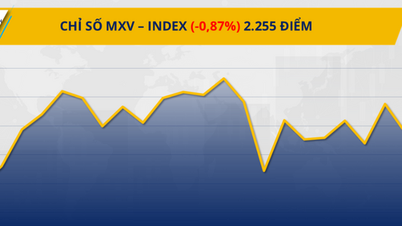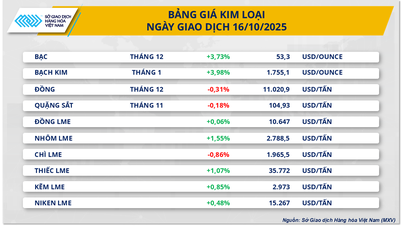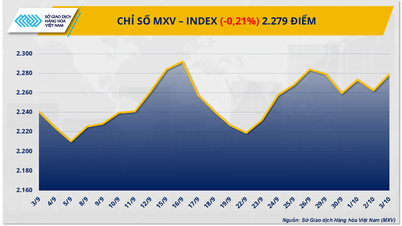
Oil prices turned weaker as the US dollar strengthened
According to MXV, the recovery of oil prices since the end of last week was halted in yesterday's trading session when the greenback unexpectedly increased sharply. At the end of the session, WTI oil prices fell 0.8% to 60.56 USD/barrel, while Brent oil also lost 0.77% to 64.34 USD/barrel.

In yesterday's trading session, the Dollar Index climbed to 100.19 points - the highest level since late May. This increase mainly came after the speech of the Chairman of the US Federal Reserve (Fed) Jerome Powell affirmed that the agency will not conduct any more interest rate cuts in the rest of the year. The move to maintain a tight monetary policy helps the USD maintain its value and attract safe-haven flows, while making oil more expensive for international investors.
According to the Fed, keeping interest rates unchanged to control inflation is still higher than the 2% target, but this policy makes it difficult for businesses to access capital, slowing economic growth. A new report from the Institute for Supply Management (ISM) shows that the US manufacturing PMI index in October continued to weaken, below the 50-point threshold for eight consecutive months.
The situation is not any better in China, where the October PMI index released by S&P Global and the National Bureau of Statistics both recorded a decline. According to the NBS, the manufacturing purchasing managers index (PMI) fell from 49.8 points in September to 49 points, marking the seventh consecutive month of contraction. The information is raising market concerns about the health of the world's two leading economies as well as the energy demand of the world's two largest crude oil consumers.
The Fed's move to keep interest rates unchanged is also reinforcing the trend of safe haven money flowing into the USD when there is still much uncertainty in the US political arena, especially when the federal government has officially entered its 36th day of shutdown, creating the longest federal government shutdown in US history. The continued US government shutdown not only puts pressure on economic growth but also contributes to increasing anxiety, causing investors to prioritize safe assets, while reducing interest in risky markets such as crude oil.
In another related development, contrary to the downward trend of the world oil market, natural gas prices in the US have recorded a consecutive increase in the last five sessions. At the end of yesterday's trading session on the NYMEX floor, natural gas prices increased by 1.8% to 4.34 USD/MMBtu, reaching the highest peak since March this year.
The main reason for this increase is the cold weather, marking the beginning of winter in the US and other Northern Hemisphere countries, leading to a surge in heating demand. According to data from BloombergNEF, not only domestic natural gas consumption increased sharply, but natural gas exports from the US were also recorded to increase to a high level in the last trading day.
Copper prices extended their decline to the fourth consecutive session.
Pressure from the strengthening USD is also weighing on the metal market, causing copper prices to continuously weaken over the past four sessions. This is also the lowest price recorded in the past three weeks. Specifically, COMEX copper prices fell 2.4% to $10,909.6/ton, while LME copper also lost 1.8% to only $10,663.5/ton.

In addition to the pressure from the strong dollar, the copper market is also under great pressure from weak manufacturing activities in China - the world's largest copper consumer - when the country's manufacturing PMI index fell to 49 points.
The outlook for copper consumption has become even bleaker as China, for the first time in more than a decade, has removed electric vehicles (EVs) from its list of strategic industries in its 2026-2030 five-year development plan, citing overcapacity in the sector.
In addition, the China Nonferrous Metals Industry Association (CNMIA) has proposed a capacity ceiling mechanism for the copper, lead and zinc smelting industry to address the fierce competition among factories amid the scarcity of ore supply. This has forced many enterprises to accept decreasing profits to gain access to input materials.
In the short term, the capacity cap is expected to reduce copper smelter activity, thereby reducing demand for copper concentrate and putting pressure on prices. However, in the longer term, as mill margins improve and the market balances out, the mechanism could be relaxed.
On the other hand, concerns about supply shortages have somewhat curbed the decline in copper prices. The world’s largest copper producer, Codelco (Chile), has just lowered its 2025 production forecast to 1.31-1.34 million tonnes, down about 30,000 tonnes from its previous forecast. Meanwhile, major mining groups such as Glencore and Anglo American announced that copper production in the first nine months of the year fell by 17% and 9%, respectively, compared to the same period last year.
Source: https://baotintuc.vn/thi-truong-tien-te/dong-usd-manh-len-keo-gia-hang-hoa-dong-loat-giam-20251105083151622.htm




![[Photo] Opening of the 14th Conference of the 13th Party Central Committee](https://vphoto.vietnam.vn/thumb/1200x675/vietnam/resource/IMAGE/2025/11/05/1762310995216_a5-bnd-5742-5255-jpg.webp)





























![[Photo] Panorama of the Patriotic Emulation Congress of Nhan Dan Newspaper for the period 2025-2030](https://vphoto.vietnam.vn/thumb/1200x675/vietnam/resource/IMAGE/2025/11/04/1762252775462_ndo_br_dhthiduayeuncbaond-6125-jpg.webp)











































































Comment (0)